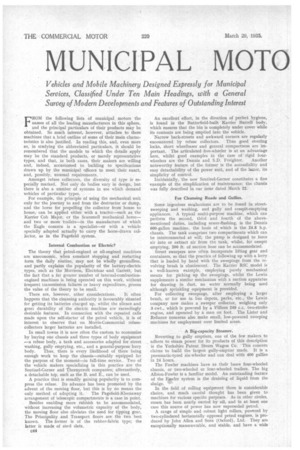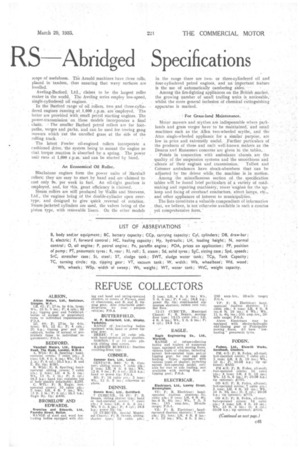MUNICIPAL MOTO
Page 98

Page 99

If you've noticed an error in this article please click here to report it so we can fix it.
RS Abridged Specifications FROM the following lists of municipal motors the names of all, the leading manufacturers in this sphere, and the principal particulars of their products may be obtained. So much interest, however, attaches to these machines that a brief outline of some of their main characteristics is also justified. In reading this, and, even more so, in studying the abbreviated particulars, it should be remembered that the models to which the details apply may be the standard products, or merely representative types, and that, in both cases, their makers are willing and, indeed, accustomed to building to specifications•drawn up by the municipal officers to meet their exact,
and, possibly, unusual requirements.
Amongst refuse collectors, the diversity of type is especially marked. Not only do bodies vary in design, but there is also a number of systems in use which demand vehicles of particular types.
For example, the principle of using the mechanical unit only for the journey to and from the destructor or dump, and the horse for propelling the collector from house to house,can be applied either with a tractor—such as the Harrier Cob Major, cr the Scammell mechanical horse— and two or more trailers—in the manufacture of which the Eagle concern is a specialist—or with a vehicle specially adapted actually to carry the horse-drawn collector, as in the Pagefield system.
Internal Combustion or Electric?
The theory that petrol-engined or oil-engined machines are uneconomic, when constant stopping and restarting form the daily routine, may not be wholly groundless, and partly explains the popularity of the battery-electric types, such as the Morrison, Electrical.and Garrett, but the fact that a far greater number of internal-combustionengined machines is being operated on this work, without frequent transmission failures or heavy expenditure, proves the value of the theory to be small.
There are, however, other considerations. It often happens that 'the cleansing authority is favourably situated for getting its batteries charged up, whilst the silence and great durability of the electric machine are exceedingly desirable features. In connection with the repeated calls made upon the self-starter of the petrol vehicle, it is of interest to observe that on Morris-Commercial refusecollectors larger batteries are installed.
In small towns it is now often the custom to economize by buying one chassis and three types of body equipment —a refuse body, a tank and accessories adapted for street washing, gully emptying, etc., and a general-purpose lorry body. Thus, there is every likelihood of there being enough work to keep the chassis—suitably equipped for the purpose of the moment—in full-time service, Two of the vehicle makers specializing in this practice are the Sentinel-Garner and Thomycroft companies; alternatively, a detachable top, such as the B. and E., can be used.
A practice that is steadily gaining popularity is to compress the refuse. Its advance has been promoted by the advent of the moving floor, but this is by no means the only method of adopting it. The Pagefield-Kleenaway arrangement of telescopic compartments is a case in point.
Besides enabling more rubbish to be accommodated, without increasing the volumetric capacity of the body, the moving floor also obviates the need for tipping gear. The Principality and Transport floors are the two best known. The former is of the rubber-fabric type; the latter is made of steel slats.
c44 An excellent effort, in the direction of perfect hygiene, is found in the Butterfield-built Karrier Burrell body, which ensures that the bin is completely under cover while its contents are being emptied into the vehicle.
Narrow back-streets and awkward corners are regularly encountered by refuse collectors. Thus good steering locks, short wheelbases and general compactness arc important. The articulated five-wheeler is at an advantage here, whilst good examples in the case of rigid four wheelers are the Dennis and S.D. Freighter. Another noteworthy feature of the former is the accessibility and easy detachability of the power unit, and of the later, its simplicity of control.
Incidentally, the new Sentinel-Garner constitutes a fine example of the simplification of maintenance: the chassis was fully described in our issue dated March 22.
For Cleansing Roads and Gullies.
Some ingenious mezhanisms are to be found in streetsweeping and washing, and gully and cesspit-emptying appliances. A typical multi-purpose machine, which can perform the second, third and fourth of the abovementioned duties, including sewer-flushing, is the Dennis 600-gallon machine, the basis of which is the 24.8 h.p. chassis. The tank comprises two compartments which can be interconnected at will; the pump is designed to force air into or extract air from the tank, whilst, for cesspit emptying, 200 ft. of suction hose can be accommodated.
Street sweepers now often incorporate lifting gear and containers, so that the practice of following up with a lorry that is loaded by hand with the sweepings from the revolving brush is obsolescent. The Harrier RSC model is a well-known example, employing purely mechanical means for picking up the sweepings, whilst the Lewin supplements a similar mechanism with a suction apparatus for drawing in dust, no water normally being used although sprinkling equipment is provided.
For collecting sweepings, after employing a larger brush, or for use in bus depots, parks, etc., the Lewin company now makes a sweeper collector, weighing only 3 cwt., which is powered by a Villiers 249 c.c. two-stroke engine, and operated by a man an foot. The Lister and Reliance concerns also make small, low-powered sweeping machines for employment over limited areas.
A Big-capacity Steamer.
Reverting to gully emptiers, one of the few makers to adhere to steam power for its products of this description is the Yorkshire Patent Steam Wagon Co. This concern claims to build the largest gully-emptier made. It is a pneumatic-tyred six-wheeler and can deal with 400 gullies in 24 hours.
The Fowler machines have as their bases four-wheeled chassis, or two-wheeled or four-wheeled trailers. The big Albion-Fowler is a familiar model. An outstanding feature of the Fowler system is the draining of liquid from the sludge.
In the field of rolling equipment there is considerable choice, and much careful thought has been given to machines for various specific purposes. As in other circles, steam has been nearly ousted by oil, and in at least one case this source of power has now superseded petrol.
A range of simple and robust light rollers, povieared by two-cylindered horizontally opposed petrol engines, is produced by John Allen and Sons (Oxford), Ltd. They are exceptionally manceuvrable, and stable, and have a wide
scope of usefulness. The Arnold .machines have three rolls, placed in tandem,thus ensuring that wavy surfaces are
. levelled.' •
AveIing-Barford, Ltd., claims. to be the largest roller maker in the world.. The Aveling series employ low-speed,
single-cylindered oil engines'. • . In the Barford range of oil rollers, two and three-cylin
• dered engines running at ,1,000 .r.p,rn. are employed. The . latter are provided .with. small petrol starting.engines. The power-transtnission ' on . these . models incorporates a final . chain. The smailer Barford Petrol rollers are for focitpaths, verges and parks, and can .be used for, towing. gang mowers 'which cut the unrolled grass at the side of 'the
rolling. track.
The latest: Fowler oil-engined rollers incorporate •a cushioned drive,:the system being to mOunt the engine so that 'torque .reaction is .absorbed by a spring. The power unit runs At 1,000 r.p.m. and can be started by hand.
An Economical Oil Roller.
Blackstone engines form the pOwer units of Marshall rollers; they are easy to start hy hand and are .claimed to cost only Os. per week in fuel. An oil-tight gearbox is employed, and, for this, great efficiency is claimed.
Steam rollers are still produced by WalliS and Steevens, Ltd., the engines being of the double-Cylinder open overtype, and design,ed to give quick. reversal of rotation. Stearn-ja.elteted cylinders are used, the valves being of the piston type, with renewable liners.. On the other Models in the range there are twoor three-cy-lindered oil and four-eylindered petrol engines, and an important feature is the use of automatically _cambering axles, • Among the fire fighting appliances on the 'British market, the growing number of small trailing units is noticeable, whilst the more general inclusion of chemical extinguishing apparatus is marked.
. . " • ' ,
For Grass-land Maintenance.
Motor mowers and scythes are indispensable where parklands and grass verges' have to be maintained, and small machines such as the Allen two-wheeled scythe; and the Atco single-wheeled appliande for a similar purpose, are
• low in price and extrenfely useful, Further particulars of the products of these and such well-known. makers as the
• Dennis and Ransornes concerns are given in the tables.
Points in connection .with ambulance chassis are the quality of the suspension systems and the smoothness and
siletiOe of their enginët and transmission, Talbot and Calmer ambulances have shock-absorbers that can be adjusted by the driver while the machine is in motion. Among the miscellaneous section of the specification
• tables will be found brief particulars of a variety of road making and repairing machinery,' tower wagem2 for the upkeep and fixing of overhead conduetors, street lamps, etc., and other appliances of interest to municipalities: The lists constitute a valuable compendium of information that we believe is not.otherwise available in such a concise yet comprehensive form,"




































































































































































